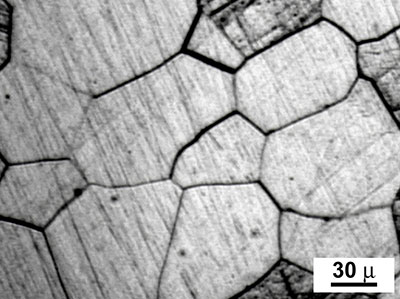By The Texas A&M University System National Laboratories Office
Dinakar Sagapuram, Ph.D. from the Texas A&M University Department of Industrial and Systems Engineering and Osman El-Atwani, Ph.D. and Yongqiang Wang, Ph.D. from Materials Science at Radiation and Dynamics Extremes Group at Los Alamos National Laboratory (LANL) are using new metal manufacturing techniques to create stronger materials that have a higher capacity to withstand radiation from nuclear reactors.

Photo Credit: Edward Pleshakov, CC BY 3.0, via Wikimedia Commons
Most of the engineering metals used today are polycrystalline, which means that they are made up of many individual crystals or grains packed together. One type is nanocrystalline metals, which have a grain size less than 100 nanometers and are exceptionally strong. They recently became a focus of interest in the nuclear materials community after researchers found that these fine-grained metals have a high irradiation tolerance.
The downside of relying on nanocrystalline metals is the lack of suitable manufacturing processes that produce them in large volumes and thin sheet metal forms, which is where many important applications lie. Rolling is a well-established method for manufacturing thin metal sheets. The rolling process involves several steps in which the material is heated and manipulated, during which the grain sizes increase. As a result of these processes, it is extremely difficult to refine the grain size to anything smaller than a micron during the rolling process.
The process the team has been developing focuses on producing thin metal sheets while maintaining a small grain size. Sagapuram explained, “The process involves ‘peeling’ a thin continuous metal strip directly from a solid metal feedstock surface using a knife edge, wherein we exploit the extreme plastic deformation and heat that is generated as part of the process to break down the grain size to sub-micron levels.”
Another unique feature of the process is that it can produce a sheet of metal in a single step. The resulting sheet comes in forms and sizes that are easy to use for a variety of structural applications.
This particular collaboration is significant because it demonstrates a strong application for a new technology. Sagapuram shared that, “In terms of end users, we have been so far thinking about primarily the automotive and electric power industries where there a strong need exists for high-strength sheet materials.” But during our discussions with LANL, it has become clear that they also have a great potential to improve the performance of nuclear reactors”
Wang explained, “LANL’s expertise in irradiation materials science and irradiation capabilities and characterizations could help evaluate and expand potential applications of these materials in nuclear reactor environments.”
As Sagapuram pointed out, there are several applications for this new manufacturing process such as the automotive and electrical power industries, in addition to nuclear applications. He also explained that it would positively affect the sheet metal manufacturing industry by providing a less energy-intensive, more efficient process than rolling.
